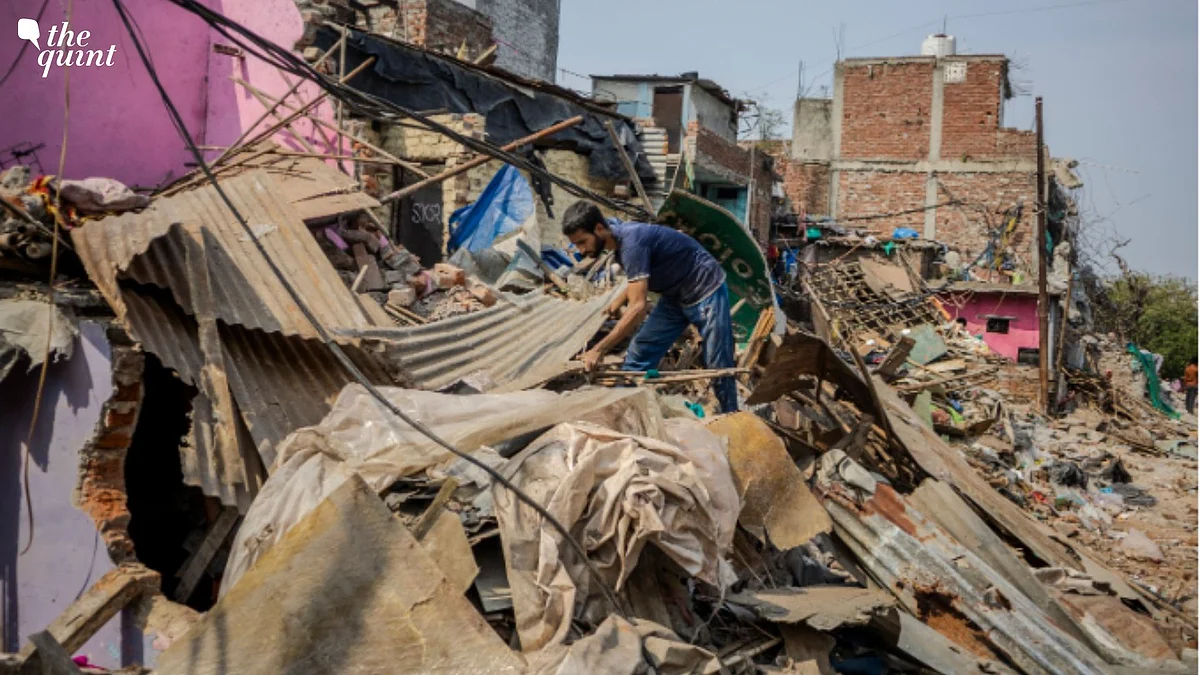'Our Homes Reduced To Rubble': Aftermath of Delhi's Taimoor Nagar Demolition
Most residents in Taimoor Nagar are migrants from Bihar and Uttar Pradesh.

advertisement
Riza stands in what used to be her home, holding her hand above her eyes to block the sun. Now there’s no roof — just open sky.
“This used to be my house,” the 12-year-old says quietly. “That was the kitchen, and where my mother used to cook delicious food.”
Riza standing next to the rubble which used to be her home.
(Photo: Shivansh Srivastava)
On 5 May, bulldozers rolled into Indira Gandhi Camp, Part I, located in Taimoor Nagar, a densely populated neighbourhood in Southeast Delhi. The demolition was carried out by the Delhi Development Authority (DDA) and the Municipal Corporation of Delhi (MCD), under the supervision of a Special Task Force (STF) constituted by the Delhi High Court. The court had authorised the STF to remove obstructions and encroachments hindering the Taimoor Nagar drain.
Demolition in action at Taimoor Nagar.
(Photo: Shivansh Srivastava)
'We Paid Money, We Were Promised a Home'
“We were promised a house under the ‘Jahan Jhuggi, Wahan Makaan’ scheme,” adds Bano. “We paid Rs 1.25 lakh, like they asked. But the government didn’t give us anything.”
Bano and her family of 11 people were residents of Taimoor Nagar. “We built this place little by little over 20 years. In one day, they destroyed everything.”
Bano (second from right) sits on a broken cot with her family, surrounded by what’s left of their home.
(Photo: Shivansh Srivastava)
The 'Jahan Jhuggi, Wahan Makaan' scheme was launched in 2015 to provide in-situ housing to slum dwellers. Residents were required to submit documents, and in many cases, pay registration or processing fees ranging from Rs 70,000 to Rs 1.5 lakh. However, several families claim they received no allotment—and no rehabilitation plan was provided before demolition.
Several families claim they received no allotment—and no rehabilitation plan was provided before demolition.
(Photo: Shivansh Srivastava)
According to the DDA’s submission to the Delhi High Court, the affected jhuggi dwellers did not possess the required eligibility certificates under the Delhi Slum and JJ Rehabilitation and Relocation Policy, 2015—a condition for receiving alternative accommodation.
However, in response to Unstarred Question No. 283 in the Lok Sabha, the Union Minister of Housing and Urban Affairs had acknowledged that residents of Taimoor Nagar and Indira Gandhi Camp are eligible for alternative housing. But in the absence of documented eligibility certificates, that acknowledgment did not translate into relief for the displaced families.
People are managing to live through the rubble.
(Photo: Shivansh Srivastava)
'Noise When Demolition Happens, Nothing After'
“There’s noise when the demolition starts, cameras and all. But after that, no one comes. When poor people’s homes turn to rubble, no one helps,” says Aarif, father of two kids.
Aarif walks through the debris of his house, picking through what little is left.
(Photo: Shivansh Srivastava)
Taimoor Nagar is a neighbourhood in Southeast Delhi, located near New Friends Colony and Kalindi Colony—two of Delhi’s more affluent areas.
The settlement of Indira Gandhi Camp dates back to around 1985, with most residents having migrated from Bihar and Uttar Pradesh. The area has a significant working-class Muslim population. Many residents are employed as domestic workers, drivers, security guards, and sanitation staff in the surrounding colonies.
Delhi is home to approximately 15 lakh slum voters, spread across 675 slums and over 1,700 jhuggi jhopri clusters.
Aftermath of demolition, broken houses, and scattered belongings.
(Photo: Shivansh Srivastava)
Many of these settlements exist in legal limbo, deemed “illegal” and subject to eviction without adequate rehabilitation.
Family leaving Taimoor Nagar with whatever they could pack to live in a safer space.
(Photo: Shivansh Srivastava)
(The Quint has reached out to the DDA and the MCD for their comments. The story will be updated as and when they respond.)